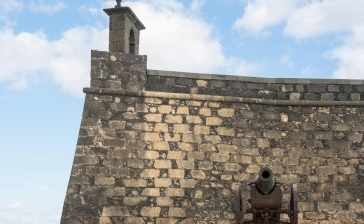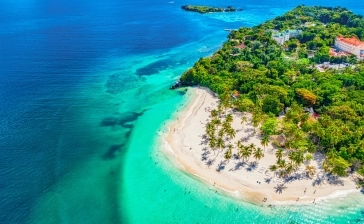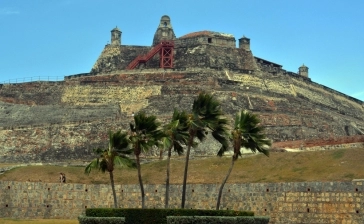Cartagena de Indias, located on the Caribbean coast of Colombia, is a city that captures the interest of travelers from around the world thanks to its rich history, stunning architecture, and vibrant culture. Known for its charming historic center, declared a World Heritage Site by UNESCO, Cartagena invites exploration of its colorful streets, majestic balconies, and fortifications that tell tales of bygone eras. In this introduction, we offer a look at Cartagena from the perspective of a tourist using a wheelchair, highlighting not only its history and curiosities but also accessible activities that guarantee an unforgettable experience.
Founded in 1533 by the Spanish conqueror Pedro de Heredia, Cartagena de Indias was an important port during the colonial era, serving as the gateway for treasures bound for Spain and as a fortress against pirate attacks. The walls surrounding the old city, built in the 16th century, testify to its past as one of the most fortified ports in the Caribbean. Over the years, Cartagena has not only preserved its historical architecture but has also blended its rich heritage with a dynamic contemporary culture.
Cartagena de Indias is home to approximately 1 million inhabitants, reflecting a vibrant mix of cultures. The city operates in the GMT-5 time zone and uses the Colombian peso (COP) as its official currency. A curious fact is its tropical climate, which ensures warm temperatures and a sunny atmosphere almost all year round, ideal for those looking to enjoy its beaches and outdoor activities.
The region's favorite dish is rice with coconut, fried fish, and patacones, a testament to the Caribbean influence on its cuisine. This dish, along with other local delicacies like ceviches and arepa de huevo, reflects the rich biodiversity of Colombia and its coast.
On the other hand, Cartagena de Indias has made significant progress in terms of accessibility, offering wheelchair users the chance to enjoy its attractions without worry.
The heart of Cartagena is its walled city, where cobblestone streets and historic plazas create a magical atmosphere. Although some areas may be more challenging in a wheelchair due to uneven paving, many of the main attractions are accessible. Plaza Santo Domingo, with its numerous cafes and the famous La Vitrola restaurant, is a good starting point to feel the city's pulse.
The Castillo de San Felipe de Barajas is one of the most impressive military works of the colonial period in America. Although full wheelchair access may be limited, significant areas of the castle have been adapted for enjoyment by all visitors.
We also want to highlight the Getsemaní neighborhood, known for its street art and bohemian culture, which is mostly accessible. Here, visitors can enjoy colorful murals and a lively atmosphere that reflects Cartagena's youthful spirit.
Lastly, we cannot forget its museums and galleries, as Cartagena has several of them, like the Museo del Oro Zenú, which offers ramps and adequate access for visitors with reduced mobility. These cultural spaces offer a deep look into Colombian history and art.
Regarding transportation, we must say that although Cartagena has improved in accessibility, transportation remains an area with shortcomings since most of its public transport is not adapted for people with reduced mobility… Therefore, we recommend seeking taxi services or private transportation that offer adapted vehicles.
Assistance and local guides: Considering the use of local tourist guides can enrich your experience. Many are familiar with the needs of tourists with reduced mobility and can tailor visits to your interests and requirements. Additionally, they offer a unique perspective on Cartagena's history and culture.
Remember, Cartagena is much more than its walled city. Areas like Bocagrande offer more accessible beaches and modern shopping centers. Even some of these places have been adapted with ramps and walkways to facilitate beach access for people in wheelchairs.
The cuisine, music, and joy of its people make Cartagena a destination that captures the hearts of those who visit it. From its music and film festivals to the cultural events held throughout the year, there's always something to discover and enjoy, regardless of physical limitations.
In conclusion, Cartagena de Indias is a destination overflowing with history, culture, and beauty. While traveling with a wheelchair may present some challenges, the city is increasingly prepared to welcome all visitors with open arms. With careful planning and an adventurous spirit, the wonders of Cartagena are within reach for everyone. Its rich history, combined with a vibrant contemporary life and efforts towards greater accessibility, make it an exceptional tourist destination for people with mobility issues. Discovering Cartagena is to immerse oneself in a world where the past and present coexist in harmony, inviting everyone to be part of its ongoing legacy.
In this section, we provide the limited contact information we have been able to find regarding the tourism offices in Cartagena de Indias.
It is known that in the city hall building there is a section dedicated to tourism where they can assist you and provide information about accommodations, transportation, activities, and more.
Additionally, we have the website and contact information for Cartagena Tourism.
Contact information:
At the airport:
At the Rafael Núñez International Airport in Cartagena de Indias, you will find a series of services aimed at improving travelers' experience.
For instance, there are several travel agencies on the second floor of the terminal, in the central corridor sector. These agencies, like Aviatur, Gema Tour, and others, offer travel packages and tours for the days you wish to stay in the city, which can be very useful for planning your activities in Cartagena de Indias.
Moreover, the airport has a 24-hour information desk available in the central hall, opposite the check-in offices, where you could obtain general information and assistance during your stay.
Airport:
The Rafael Núñez International Airport, serving the city of Cartagena de Indias, is a key gateway for national and international tourists wishing to explore the beauty and charm of this historic Colombian city. Acknowledging the importance of accessibility and inclusion, the airport has implemented a series of services and facilities aimed at ensuring all passengers, including those moving in wheelchairs, enjoy a comfortable and smooth experience from their arrival until their departure.
The Rafael Núñez International Airport is quite well-prepared in terms of accessibility, offering various facilities for wheelchair users:
Access and Entrances: All the main entrances to the airport are equipped with ramps and automatic doors to facilitate access for wheelchair users. Additionally, the sidewalks outside the airport have suitable slopes.
It also has help points and information counters strategically located throughout the airport, where staff is available to assist passengers with reduced mobility. These employees can offer assistance for check-in, navigating the airport, and boarding.
The airport provides personalized assistance services from the moment of arrival to boarding, including help moving through the airport, accessing restrooms, and boarding the plane using lift systems or special wheelchairs for transferring to plane seats.
It has adapted restrooms equipped with facilities for wheelchair users available at various locations within the airport, ensuring accessibility and comfort for all passengers.
To facilitate mobility within its facilities, the airport has ramps, spacious elevators, and wide corridors, allowing wheelchair users to move easily between different areas, including check-in zones, waiting rooms, and boarding gates.
Additionally, it has a parking area with reserved and conveniently located spaces for vehicles transporting people with disabilities or reduced mobility, offering close access to the terminal entrances.
The staff of the Rafael Núñez International Airport is trained to meet the needs of passengers with disabilities, ensuring a pleasant and respectful experience. Employees are available to provide guidance, answer questions, and assist in specific situations requiring special attention.
The Rafael Núñez Airport features signage and visual and auditory announcements designed to be clear and easily understandable, helping wheelchair users find their way and access necessary services without inconvenience.
Conclusion
The Rafael Núñez International Airport strives to be an inclusive and accessible space for all passengers, including those who use wheelchairs. With its adapted facilities, trained staff, and personalized assistance services, the airport ensures that accessibility is a priority, facilitating a safe and comfortable journey for all visitors to Cartagena de Indias. The dedication to continuous improvement of facilities and services reflects the airport's commitment to inclusion and accessibility, ensuring all passengers, regardless of their mobility needs, can enjoy a positive travel experience.
The Rafael Núñez International Airport not only serves as a significant connection point for travelers visiting Cartagena but also represents a model of accessibility and inclusion, striving to meet the needs of all passengers and ensuring that each journey begins and ends under the best possible conditions.
Transportation from the airport to the city center:
The Rafael Núñez International Airport is conveniently located just a few kilometers from the historic center of Cartagena de Indias, facilitating the transfer of travelers to and from the heart of the city. Although Cartagena does not have a train or metro system, there are several transportation options adapted for wheelchair users, including buses, taxis, and private car services. Here we detail the available options:
Bus:
Public Transportation: Cartagena offers some urban bus routes that connect the airport with different parts of the city, including the center. It is important to check with local bus companies about the availability of vehicles adapted for wheelchairs, as the inclusion of these services may vary. Regardless, we recommend taking a taxi or private car since the city center is only a few km from the airport, and the taxi fare is not very expensive.
Taxi:
Adapted Taxis: Some taxi companies in Cartagena have vehicles adapted for wheelchair users. These taxis are equipped with ramps or lifts and sufficient space to accommodate the wheelchair. It is recommended to book these services in advance to ensure their availability.
We provide the contact of a company that has adapted vehicles:
- Guianza Express SAS
- Address: Pie de la popa Cra 20C 17 1B Cartagena, Bolívar
- Phone: (+57) 317 666 7192 or (+57) 300 277 6850
- Email: info@guianzaexpresscartagena.com
- Web: guianzaexpress.com
Transportation Apps:
Platforms like Uber and other transportation apps operate in Cartagena and may offer options for adapted vehicles. Through these apps, users can request rides in vehicles equipped to meet their specific needs, although availability may vary.
Bocagrande Beach:
This iconic sector of Cartagena is not only known for its vibrant life, golden sand, and crystal-clear waters but also for its commitment to accessibility, making it an inclusive destination for all visitors.
Bocagrande, located near the historical heart of Cartagena, is one of the most modern and touristic areas of the city. The beach stretches along a peninsula surrounded by hotels, restaurants, and shops, offering a perfect mix of urban amenities and natural beauty.
What sets Bocagrande Beach apart is its infrastructure designed to ensure accessibility for people with reduced mobility, as it features:
Boardwalks: The beach has firm and stable boardwalks that allow people in wheelchairs to easily access the sand and approach the sea without difficulty. These boardwalks are wide and well-maintained, ensuring safe movement from the promenade to strategic points near the water.
Assistance Personnel: Aware of the importance of a safe and comfortable experience for all, Bocagrande offers trained assistance personnel to help visitors in wheelchairs. This service includes help with mobilization on the beach, entering the sea if conditions permit, and any other assistance needed during the visit.
Appropriate Rest Areas: The beach has shaded rest areas equipped with adapted chairs and tables, where visitors can relax, enjoy a meal, or simply admire the sea view. These areas are designed to be accessible and comfortable for everyone.
Accessible Sanitary Facilities: Adapted restrooms and easy-access showers are available, ensuring visitors' comfort during their stay at the beach.
In addition to its accessibility, Bocagrande Beach offers a variety of activities and services that make it an attractive destination:
Water Sports: For those interested in aquatic activities, accessible options such as boat rides with assistance for boarding and disembarking are offered.
Local Cuisine: Along the beach and its surroundings, numerous restaurants and food stalls serve local and international delicacies, many of which are accessible to people in wheelchairs.
Nightlife and Entertainment: Bocagrande is also a vibrant place at night, with accessible entertainment options ranging from quiet bars to nightclubs.
Conclusion:
Bocagrande Beach in Cartagena de Indias stands out as an exemplary destination where tourist spots can be inclusive and accessible, allowing all visitors, regardless of their physical abilities, to enjoy the beauty and activities offered by the Colombian Caribbean. With its commitment to accessibility, Bocagrande is not only a paradisiacal beach but also a place where inclusion is a priority, ensuring that all visitors have an unforgettable experience.
Getsemaní Neighborhood:
The Getsemaní Neighborhood is a historical and cultural gem that dazzles visitors from around the world with its vibrant street life, artistic murals, and the warmth of its people. For those traveling in wheelchairs, Getsemaní emerges as an inclusive destination, filled with accessible experiences that guarantee a memorable and comfortable visit. Below is a tour specially designed for tourists with reduced mobility, ensuring they can enjoy the beauty and charm of the neighborhood without obstacles.
The ideal starting point is Plaza de la Trinidad, the vibrant heart of Getsemaní. This accessible square, surrounded by colorful colonial buildings, is the stage for cultural gatherings and outdoor activities. Here, visitors can admire the statue of priest Pedro Romero, a local hero who advocated for equality. The wide-open spaces allow for easy wheelchair navigation, while nearby cafes and restaurants offer ramps and appropriate access for a worry-free culinary experience.
Getsemaní is famous for its street art; the murals that adorn its streets tell stories of resistance, culture, and everyday life. A stroll down Calle de la Sierpe provides an outdoor gallery accessible to all. This path is relatively well-paved, facilitating wheelchair movement. It is recommended to take this tour during the cooler hours of the day to avoid the midday heat.
Following Callejón Angosto, visitors will find one of Getsemaní's most emblematic streets. Though it may present some difficulties due to its narrowness and uneven pavement in sections, it is here where the neighborhood's living history is most intensely felt. Establishments in this area have worked to be more inclusive, offering help when necessary to ensure all tourists can fully enjoy the experience.
From here, we move to the Iglesia de la Santísima Trinidad, located opposite the square of the same name, is a historic landmark of Getsemaní. This religious building, accessible to wheelchair users, offers a window into Cartagena's colonial past. Its interior, restored and maintained, invites reflection and contemplation, providing access ramps and appropriate spaces for visitors with reduced mobility.
For those interested in culture and the arts, the Ciudad Móvil Cultural Center is a must-visit. Located in an adapted colonial house, it offers artistic exhibitions and workshops accessible to everyone. This center has worked hard to remove physical barriers, ensuring its spaces are fully accessible to wheelchair users, making it an inclusive venue for artistic expression and cultural gathering.
Another important spot in the neighborhood is the Centenario Park, located on the outskirts of Getsemaní, offers an oasis of nature in the middle of the city. With paved paths and rest areas, it is an ideal space to enjoy a peaceful afternoon outdoors. Accessibility is guaranteed, with well-maintained paths that allow effortless exploration of the park and its commemorative monuments.
This tour through Getsemaní, designed for wheelchair tourists, highlights the importance of inclusion and accessibility in tourism. Although there are still challenges to overcome, the move towards greater accessibility is evident, allowing all visitors to experience the cultural and historical richness of this emblematic neighborhood of Cartagena de Indias.
San Diego Neighborhood:
The San Diego Neighborhood in Cartagena de Indias is another historical treasure that is part of the city's famous walled center. Known for its tranquil atmosphere, cobblestone streets, and beautiful plazas, San Diego is a charming destination for all tourists, including those with reduced mobility or in wheelchairs. Once again, we propose a tour designed to ensure that visitors in wheelchairs can explore and enjoy the wonders of San Diego with the greatest comfort and safety possible.
Plaza de San Diego serves as the ideal starting point for this tour. Wide and accessible, this plaza is the heart of the neighborhood, surrounded by ancient houses turned into boutiques, restaurants, and hotels. The plaza is easily navigable in a wheelchair, offering a pleasant welcome with its leafy trees and benches where one can rest and watch the hustle and bustle of everyday life.
Recently transformed into a modern shopping and cultural center, La Serrezuela is a must-visit in San Diego. Originally a bullring, this space has been carefully restored, preserving its historic architecture while ensuring its complete accessibility for people with reduced mobility. With ramps and elevators, visitors can explore shops, enjoy cultural shows, and taste local cuisine in various restaurants.
Heading north of the neighborhood, one finds Las Bóvedas, located in the walls surrounding the city. This set of arches was used in the past as a prison and armory, and today houses craft shops and art galleries. Although the cobblestone may present certain challenges, the area is accessible, and vendors are often very helpful, facilitating access to their premises.
Calle de Don Sancho, one of the most picturesque streets in San Diego, offers a beautiful perspective of colonial life. Although cobblestone streets are characteristic of the historic center, this area has improved in terms of accessibility, with efforts to level surfaces and provide more passable routes for wheelchairs. The carefully preserved colonial buildings provide a wonderful backdrop for a leisurely stroll.
From here, we can continue to Parque Fernández de Madrid, another green space in the heart of San Diego, offering a place of rest and recreation. Surrounded by impressive colonial houses and with a statue of the hero José Fernández de Madrid at its center, the park is completely accessible and offers a peaceful experience, away from the city's hustle and bustle.
Although cobblestone streets are part of Cartagena's charm, they can represent a challenge for wheelchairs. It is suggested to use robust and preferably motorized wheelchairs for greater comfort.
The San Diego Neighborhood offers a rich and accessible experience for tourists visiting Cartagena in wheelchairs. With its mix of history, culture, and natural beauty, along with ongoing efforts to improve accessibility, San Diego invites all visitors to discover its charms at their own pace and on their own terms.
Brasa y Barril: https://brasaybarril.com/
Offers a variety of delicious seafood dishes and North American cuisine options like burgers and barbecue, with accessible areas for visitors in wheelchairs.
Open daily from 12:00 pm to 9:30 pm.
Address and contact:
- Avenida El Bosque sector Tacarigua trv. 54#34-98, Cartagena, Colombia.
- Phone: (+57) 667 8798 or (+57) 667 8959.
El Muelle Beach Club: https://restaurantebarelmuelle.com/
Known for its beachfront location, offering Caribbean gastronomic experiences, water sports, and cocktails while enjoying a sunset. It's an accessible place, with accessible bathrooms and ramps, ideal for those looking to relax and enjoy the sun and sea.
Open Monday to Sunday from 7:00 am to 2:00 am.
Address and contact:
- Playa del Laguito Cra. 1ª # 1A-23, Cartagena de Indias, Colombia.
- Phone: (+57) 605 655 1975 or (+57) 320 3826198.
Intriga Tropical: https://intrigatropical.com/
A bar restaurant offering a unique experience in a tropical and romantic atmosphere, inspired by the Caribbean. Located in El Laguito, Cartagena de Indias, it features a varied menu highlighting its gastronomic quality, including options like grilled loin, garlic fish fillet, chicken in tamarind sauce, and more. Open every day, including holidays, from 10:00 am to 1:00 am.
The restaurant is accessible, but information about its bathrooms' accessibility was not found.
Address and contact:
- El Laguito, Avenida del Retorno, CL. 1A #1, Cartagena de Indias.
- Phones: (+57) 605 665-2683 or (+57) 320 816-8637.










